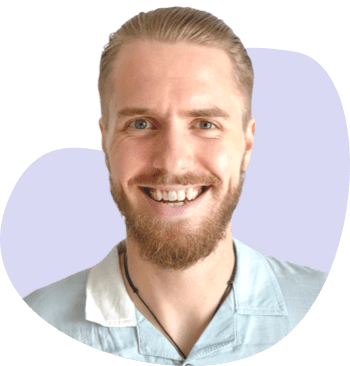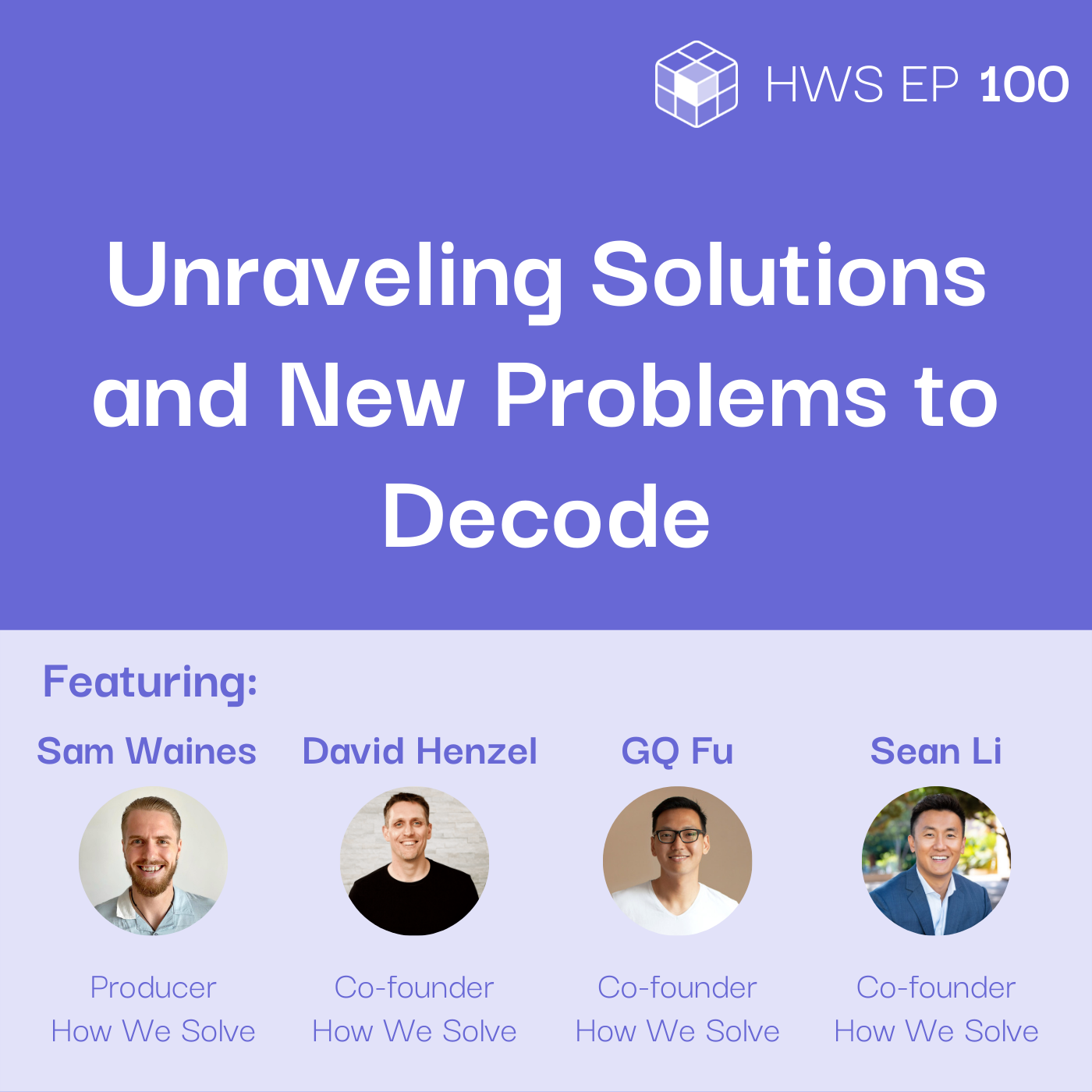Listen on:
Table of Contents:
100 Ways to Solve Business Problems
What happens when people who love sharing knowledge and exchanging experiences come together? Conversations turned into podcasts! For this episode, the founders of How We Solve, a podcast meant to help e-commerce and SaaS businesses, talk about how this platform came together, where we’re headed next, and what we can expect from them. The group shares how a simple goal of learning from industry experts and finding tried-and-tested solutions that will solve your business problems has become a regular show. Join GQ Fu, David Henzel, Sean Li, and host Sam Waines as they talk about their journey to the 100th episode of How We Solve.
Finding Smart People to Solve Tough Challenges
Towards the end of 2019, friends and colleagues David Henzel, GQ Fu, and Sean Li started conversations about business leaders and industry experts who had solved unique business challenges for e-commerce and SaaS businesses. Combining their passion for podcasting and for sharing knowledge with others, the three came together and made the show happen.
The Opportunity to Learn from Business Leaders
David shares how it all stems from the desire to meet smart people, find out how they solved difficult business challenges, and share those solutions with the world.
I think it just kind of happens out of the desire to talk to smart people who have solved tough business problems, learning from them, and sharing these with others. And I think this was the self-serving motivation from my end, to talk to smart people and have a reason to talk to more smart people that have solved hard stuff and sharing this. And also we know how the self-serving thing is giving exposure to the portfolio of businesses that I’m working with.
Sharing it with the World
That one thing that the founders share in common? It’s how this platform gave them the chance to meet amazing people. All three feel that it’s imperative to share these wonderful stories and these learning with the world.
He was interviewing amazing people. We both were just vibing off each other’s energy. I think this is a great platform. Not only selfishly, for us to meet amazing people, but also to highlight their stories and bring them and share them with the world.
Growing Organically and Improving Every Episode
GQ shares how they started recording episodes, interviewing people, and how one thing led to another. As the platform and viewership grew organically, the team always thought about how they were going to deliver better content and meaningful conversations.
Hyper-focus
One of the show’s key secrets was to specify a field where they think they can bring in experts and keep it at a sustainable pace. Picking up from Sean’s experience building the alumni podcast at UC Berkeley’s Haas Business School.
You’re trying to build your audience because you’re trying to find your target market. But with alumni podcasting, Well, the target markets, the alumni —and there’s an alumni base at every university— what I call this warm audience. So, I thought, wait, if I can do this for Berkeley, why can’t we do this for every single university? And the beauty of it was that they’re non-competitive. It’s not like Berkeley competes with Stanford for their alumni. So again, I just actually stumbled into this business where we just focus on alumni basis and providing value.
Going Live to Engage Viewers Better
The main goal of the show was to answer questions. The team noticed how they would usually have viewers who already follow or have read the guest’s work. Going live gives these listeners a platform to ask questions and make the show more interactive.
Our goal is to be able to answer the questions. I mean, we could do this for completely selfish reasons, but the main thing is we’re doing this because we want to be able to give back. In a way that’s like, “Hey, we’ve got the experience. We’ve got the knowledge. We’ve got the guests. You might have read their book, but haven’t actually got to ask them your question.” And then it’s just giving that platform for people to open up in a two-way dialogue. That’s definitely where we’re trying to push the live format. It’s not just a recording session. It’s like an interactive session as well.
Making the Show Different with Bite-Sized Content
The show focused on giving digestible content. One that’s easy to deconstruct, break down, and take actionable insights from. Making the content one that really helps solve the listeners’ problem.
The idea from the beginning was to always give actionable insights and to have it kind of really broken down, compressed. So, you can take something from it and implement it. Even if you don’t have 30 minutes to listen, you could also just flick through because, for every episode, we’re also putting not just a description, like an actual post. We’re showing some quotes from the episode, but also the actionable insights that we gleaned from that conversation.
The team wanted to make sure the content remains approachable, making sure that the topics remain relatable and easily understood.
I think that’s the one thing that I like to tack on about the How We Solve podcasts. I really enjoy that everything that we cover is very approachable. And I think part of it is because of the structure that David and GQ had carved out, in the beginning. It’s like, “Let’s keep this podcast focused and write How We Solve. This thing and then “boom, boom, boom”. Like the steps to it. And that makes it very easy to digest. A lot of podcasts, especially interview based, sometimes, like you were saying, Sam, “I like to get into the weeds of things”, that we might not be able to understand. But the How We Solve podcasts keep it useful.
Hosts Share Favorite Episodes
From the almost two years of problems they tried to solve, what were the hosts’ favorites? Sean talks about how the customer success episodes really pique his interest.
For me, it is the customer success category that I love listening to because there is no one answer for customer success. Because you have so many different types of customers and so many different types of organizations, at different stages. Especially as an entrepreneur, it’s really interesting for me to hear customer success at really early stages, versus growing stages, versus maturity stages. And I thought we had pretty good coverage of, spectrum.
Meanwhile, David, who has Aphantasia remembers the episode with Temple Grandin as a guest. Dr. Temple Grandin is well known to many for her trailblazing work as a spokesperson for people with autism and her lifelong work with animal behavior. She talks about her experiences as a professional who suffers from Hyperphantasia, the opposite condition of Aphantasia.
Temple Grandin talking about autism, and I have this condition called Aphantasia where I don’t have images in my head, and she’s the polar opposite. She only has images in her head. Very interesting person. I love the movie that was made about her life. And, this was pretty awesome. And the most reasonable one was also super cool for me because I’m a huge NPS nerd, net promoter score. I really love the concept. It’s kinda like a whole way of doing business. And I had the founder of NPS on the show.
Focusing on the Unique Challenges Faced by Growing Companies
The podcast continues to find unique challenges to solve. Moving forward from their 100th episode, the team looks into new opportunities to share knowledge outside the e-commerce and SaaS space.
Now the current school of thought is to focus on companies who are at the growth stage, not too early. Maybe 25, 50, or a hundred employees because you know these types of companies have a very different set of problems than smaller companies.
This interview is part of the How We Solve podcast. To hear more from industry experts who are solving everyday business problems, check us out on Spotify, Apple Podcasts, and on our website.
About the new host

Sam Waines
Producer and Editor of the How We Solve show, Sam joined the team in mid-2021 and has worked behind the scenes to bring all the live shows and highlight videos to life. Sam is also a content creator on YouTube and enjoys living and documenting his life as a digital nomad.
Listen on:
